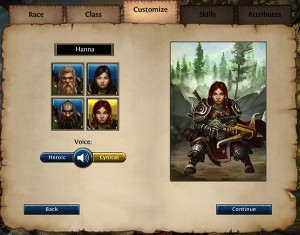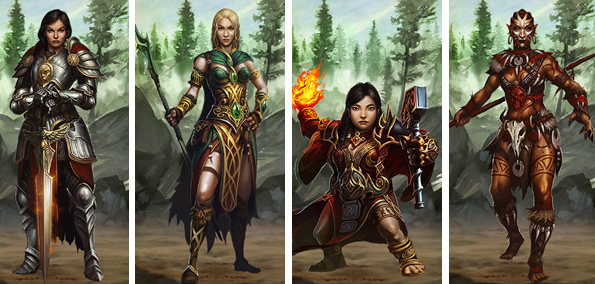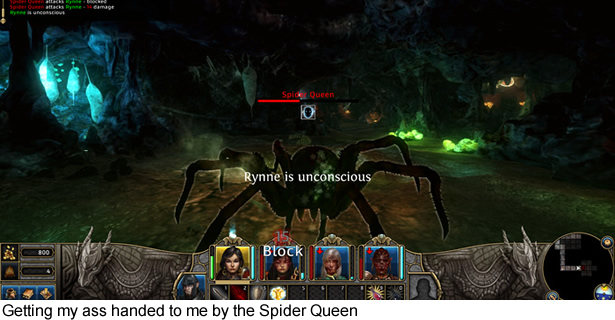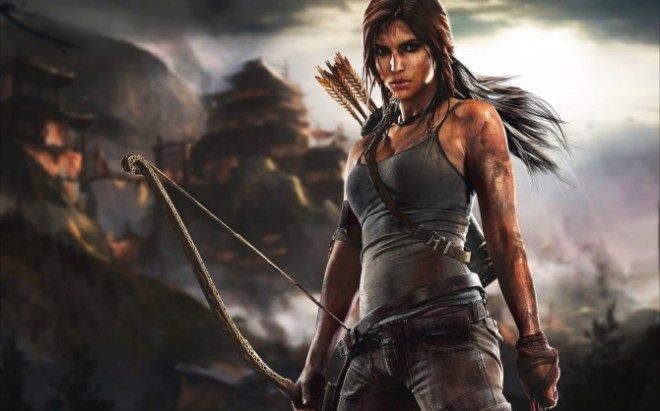Might & Magic X: Legacy is the much-anticipated tenth installment of the Might & Magic series. Fans of the game have had to wait more than a decade since the last title, so it had a bit of buzz surrounding its release on January 23rd. Because most fans of the series played the Might & Magic series throughout the 1990s, developer Ubisoft chose to wax nostalgic with this release, retaining a retro feel with Might & Magic X: Legacy, from its tile-based movement, limited budget graphics, and slow, turn-based play style that remains such a cornerstone with dungeon-crawling RPGs. With that said, Might & Magic X: Legacy is Ubisoft’s attempt to refresh the dungeon-crawling genre for contemporary gamers. And let me just say this up front: if you don’t like super difficult gameplay; strategic, slow, turn-based combat; and retro graphics, well, you aren’t going to like Might & Magic X: Legacy.
When you first launch the game, you’re given the opportunity to play in Adventurer mode or Warrior mode, depending on your preferred difficulty. I chose Adventurer because a) I’m a wimp and I hate to die, and b) I’d never played a Might & Magic game before, so I thought I’d test it out. It turns out that was a good thing because the game nonetheless still kicked my ass… but more on that later.
Next, you get to choose your party. Although the game doesn’t tell you so at this point, you get to create a party of four to take out on your adventures. The idea, like traditional dungeon-crawlers, is that you’ll strategically assemble a crew that will complement one another when doing battle. You have the option of “Manual Creation,” “Default Party,” or “Random Creation.” If you choose “Default Party,” you’ll get a male (dwarf) warrior, a male (orc) tank, a female (elf) hunter, and a female (human) mage. That is, you’ll get the tired, clichéd assembly of characters, down to the gender/class match-ups. I opted instead to manually create my team, and was given the following options:
1. Race. Options: Human, Elf, Dwarf, Orc. You are given short narratives to decide but they are markedly gendered; for instance, the Dwarf class mentions “Adult male Dwarves always wear full beards.” Really? Because: a) how is that relevant to my game play, and b) what about female Dwarves? Do you have female Dwarves? Do they have beards, too? Anyway, you eventually find out that yes, there are female Dwarves and no they don’t have beards, but at first the conventional RPG lore and race embodiments were a bit of a turn-off.
2. Class. The options here are surprisingly extensive; there are three classes per race, 12 in total:
- Human: Mercenary (warrior), Crusader (paladin), Freemage (mage)
- Elf: Bladedancer (rogue), Ranger (hunter), Druid
- Dwarf: Defender (warrior/tank), Scout (warrior/ranged), Runepriest (battle-mage)
- Orc: Barbarian (warrior), Hunter, Shaman
The idea (and hence the title of the game: Might & Magic) is that each race allows the player to choose between a “might” class, a “magic” class, and some type of hybrid class.
 3. Customize. Really the only options here are gender and overall look (mostly just a hairstyle color); there are two male options and two female options for each race/class. But, at least they attempted something in terms of identity customization. You also get to choose a name or select a random one that the game generates for you.
3. Customize. Really the only options here are gender and overall look (mostly just a hairstyle color); there are two male options and two female options for each race/class. But, at least they attempted something in terms of identity customization. You also get to choose a name or select a random one that the game generates for you.
4. Skills. You’re given a few skills to start with based on your class (such as: dual-wielding weapons, increased endurance, or boosted mana levels, but you’re also given the chance to add two skills of your choice.
5. Attributes. Once again, you’re awarded some default points in their key areas (Might, Magic, Perception, Destiny, Vitality, and Spirit) based on your class, but you’re also given five additional points to customize as you wish.
Then, you start the process over again until you have a merry band of four ready to accompany you on your adventures.
For this power hour review, I chose an all-female team (surprise!) that consisted of:
- Human Crusader (paladin)
- Dwarf Runepriest (battle-mage)
- Elf Druid (magic/heals)
- Orc Barbarian (warrior)
I will say that as I created my toons, I was disheartened to see many of the same issues we’ve seen before. The looks you have to choose from are decidedly white, with the exception of the Orcs, which are much like the witch doctor class in Diablo III: tribalized, savage, with paint obscuring their faces. As I progressed, I noticed a similar issue with the over-caricaturized voice acting and racial representations, as well. For instance, when the female Orc attacks, she screams in an unintelligible tribal language, once again marginalizing the only non-white class to the “other.” Not that I should be surprised in a game that is so focused on creating a nostalgic vibe and is clearly not concerned with modern representations of fantasy RPG characters… but, anyway. I will say, though, that I was impressed by how much clothing the females were wearing; I actually was excited to see this group of seemingly strong women go out on an adventure. So, once I had assembled my group, I was on my way.
I’d tell you about the story of the game but sadly it’s nothing we haven’t seen before. Epic battles and royalty and conflict and something something something [I got bored and tuned out and, plus: I had a crying baby]. But ultimately, what clearly matters in this game is the mechanics and nostalgia more so than any type of lore.
In terms of gameplay, there is very little tutorial to be had; the game expects you to learn it on your own. This is incredibly frustrating for a limited-time experience, such as a power hour review, as it took me nearly 10 minutes to even figure out the concept of the game. Screen movement is incredibly quick; so fast that it may make you a bit motion sick, if you have trouble with that sort of thing. And while, if you open up the game’s options, it claims that it’s best to navigate with the traditional W, A, S, and D keys, I found that I couldn’t navigate the game properly without just sticking with the arrow keypad.
The user interface (UI) of the game is terribly frustrating as well, especially to those new to the genre. The map is a coordinates-based grid that is blacked out until you discover portions of the game, with very little else to go off of. However, you can add notes to the map to keep track of certain things, which is a nice feature. The game alerts you that you will experience day and night modes, with different enemies for each, but discusses it in the concept of “tiles” (which you wouldn’t understand at all without any experience in a retro dungeon-crawler). There is also the ability to pick up and hire random additional people to your troupe (up to an additional two), but there is very little direction on how (and more importantly: why you’d want) to do that. After receiving my first hire, I had no idea what to do with him, and he abandoned me very quickly in the game because I apparently talked to an NPC that he didn’t like. The second hire was rude and completely unhelpful, simply telling me to go to my first dungeon. (I know! But where in the hell is the first dungeon?!) Ultimately, I was left to wander the game on my own, completely clueless to how to complete quests or overall what the point seemed to be.
The situation is like this: the first town you’re in (Sorpigal-by-the-Sea) is on lockdown, and no one can leave. The problem is that as I wandered the town various NPCs gave me quests, and all but two of my quests told me to leave the town. (Okay, great. But nobody is letting me leave. What do you want from me?!) The two that I actually could complete were located in “hidden tunnels” that I couldn’t find for the life of me.
As I was exploring, I experienced my first fight when I discovered a spider in a barrel. My Orc almost immediately fell “unconscious” (died) without seemingly doing anything at all. (I later discovered the spider had poisoned her, but the game didn’t tell me how to fix it (via potion) until much later in the game.) For the next 10 minutes, I wandered, repeating the same locations and clearing the entire map and trying to figure out how to revive her. Eventually I figured out I needed to press the “Rest” button; the game made me do it because apparently my characters were fatigued. From doing nothing. Well, nothing but run around in circles while I attempted to find any rhyme or reason to the game.
So anyway, I hit “Rest,” the game turned to night, and while I was trying to read my map to determine where to go, something attacked me and killed my Orc again – mere moments after I finally figured out how to revive her. Frustrating to say the least. I’m the type of player who hates to die, and I thought by choosing the easier gameplay mode—and given that I was only 20 minutes or so into the game—that I’d have an easier learning curve. I was wrong. It took me 20 minutes to even find the first dungeon.
While there, I discovered something very disheartening: My barbarian was surprisingly squishy. For a warrior class, it was shocking, actually, how much she died. Every time I revived her she died again (with a really concerned look on her face, I might add). She must have been poisoned or something, but the game never told me what to do about it. And once I figured out that I could loot some antidotes to help save her, I kept running out.
At any rate, the first dungeon was terribly difficult and frustrating. Right off the bat you’re faced with a dual combat situation, and it gets quite complicated to fight two huge spiders at once. It was certainly too much, too quickly, and lessened some of the fun of the game. I did quickly learn, though, that my magic classes had a lot of oomph, although they ran out of mana quickly, while my might classes had very little to offer aside from dying all the damn time. Their blocks would miss, their melee attacks would miss, and I mostly spent their turns (as you play, each character gets a “turn” to attack) drinking potions rather than helping out.
All four of my characters died once I met my first boss (23 minutes into the game), and in a horribly spectacular fashion. (Seriously, you should have been there.) Combat, while smooth aesthetically, makes little sense aside from button mashing whichever ability is off of cooldown. Frustrated, I reloaded the game and gave it another shot, thinking that I certainly had done something wrong… and I died again. Even worse than before. Like, seriously epic. I realized that most of my hits were missing (although there was nothing I could do about that; it was my first dungeon and I hadn’t even received any gear, nor money to buy anything worthwhile), and so most of my turns were wasted.
Honestly, this game was so frustrating that I would have quit 30 minutes in if it weren’t for the fact that I’m doing a “power hour” review. I kept going, though, you know – for you guys and everything.
You’re welcome.
Okay, so my third time through the dungeon, the game froze on the dual spider battle and wouldn’t let me do anything at all. I kept button mashing until it finally responded, but I nearly had to hard restart the game. On this third try through, I eventually defeated the Spider Queen, although it was an extremely long battle (seven+ minutes) and took a lot of effort. This time I could see that the game required some serious strategy to accomplish, even in these beginning battles of the game, although I can tell that I didn’t even begin to scratch the surface; it’s one of those games that you likely have to stick with in order to master.
Once I was done with the dungeon, I had to run all the way back to the beginning to leave. (If there was another way out, and I’d imagine that there was, I surely couldn’t find it.) I did eventually make it out of the dungeon and back to town, where the gates to leave were suddenly unblocked.
And so. With just a few minutes left in my power hour play time, I was finally able to leave the town of Sorpigal-by-the-Sea. As I did so, I was presented with a warning that because M&M X is an open world game, it was likely I’d have my ass handed to me by varying enemies of much higher levels if I wandered too far.
Great.
But, hey, at least they warned me.
Ultimately, although much of my power hour wasn’t necessarily joyous, I understand that most of the issues involved my just getting used to the game, and so I’m a bit torn on the game. In fact, now that I’ve made it through some of the initial learning curve, I find myself thinking about the game a bit more and wanting to give it another shot. Might & Magic X: Legacy is a nostalgic game, one that’s bound to appeal to you if you have the patience for super challenging (even on adventure mode), strategic, turn-based combat. The learning curve for this game is terribly high, and when compared to the flashy, narrative driven gameplay that we’re used to in more contemporary-styled titles, M&M X has very little payoff, at least on the surface. But if you’re a fan of classic 1990s dungeon-crawlers or even roguelike titles, M&M X may be worth a go. Just be prepared to have your ass kicked.






